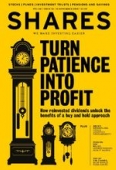Archived article
Please note that tax, investment, pension and ISA rules can change and the information and any views contained in this article may now be inaccurate.
Find out how ETFs are getting active

The global exchange-traded fund (ETF) industry is estimated to soar in value from $5tn to $30tn by 2030 according to JP Morgan as more people seek out low-cost investments.
ETFs are used by investors to match the performance of an index of assets, usually for a cheaper price than actively managed funds.
As well as growing rapidly this industry is also innovating so while historically ETFs have been almost entirely passive investments, there are an increasing number of ‘active’ products which have a fund manager in charge aiming to beat the benchmark.
One of the companies hoping to tap into the growing active ETF space is JPMorgan which three new London-listed products in October 2018.
AIMING TO BEAT THE INDEX
With these products the fund manager looks at the index it wants to beat and decides what companies it wants to go overweight or underweight on using research and future cash flow insights from its analysts.
Typically, you would expect to pay for the extra work which goes into building such a portfolio so you would expect truly active ETFs to have higher charges than their passive counterparts.
Of these new products, JPM Global Research Enhanced Index Equity (JREG) aims for a long-term return in excess of the MSCI World Index by investing in global companies.
JPM US Research Enhanced Index Enhanced Index Equity (JREU) uses a US portfolio of companies to try and beat the S&P 500.
Both ETFs have top positions in Apple, Microsoft, Amazon, Google-owner Alphabet and Johnson & Johnson. These are some of the largest companies in the world and already have a significant weighting in US and global indices, so there have to be questions on the extent to which investors are benefiting from the active management approach.
Among the top holdings for JPM Europe Research Enhanced Index Equity (JREE) are Novartis, Nestle and Unilever (ULVR) in a bid to beat the MSCI Europe Index.
This ETF tracks an index of 716 stocks, far more than most traditional active funds and considerably more than the 122 and 210 holdings in the two other aforementioned JPMorgan ETFs. You have to question whether a fund manager is really on top of everything affecting 716 companies.
In these products’ favour is their ongoing charge of 0.25%, higher than the cheapest passive ETFs which sometimes have fees as low as a few basis points but lower than most traditional active funds.
WHAT MAKES AN ETF ACTIVE?
There is significant debate over what makes an ETF ‘active’ in terms of how the investment strategy is decided and implemented.
Legal and General’s ETF head Howie Li argues for an ETF to be truly active it should be led by a fund manager and an investment team who undertake research to decide what to invest in.
The benefits of having someone take control of an ETF is that they can keep an eye on the investment universe and remove any companies if, for example, they become overvalued.
For investors considering an active ETF, Li says it is essential they understand the investment, who is involved and whether the portfolio is actually unique and if it has delivered to expectations in the past.
Active ETFs are not always as straightforward as a fund manager picking stocks. The criteria for the investment strategy may be set by the manager and implemented in an automated way.
Investors may be curious about how active ETFs are different from other investment methods such as smart beta and there is something of a grey area here.
HOW DOES SMART BETA DIFFER?
Smart beta features a ‘rules-based’ approach to investing, effectively applying a screen to the market but not making a qualitative judgement on individual stocks.
In this sense smart beta ETFs are something of a hybrid – using aspects of both active and index investing. These funds focus on incorporating assets that have certain characteristics attractive to investors, such as low volatility, good dividend yield or strong company performance.
Other examples of ETFs with ‘active’ characteristics include Robo Global Robotics and Automation Index ETF (ROBO). It tracks an index created by Robo Global made up of firms with a high sales association with robotics, automation and AI.
Robo Global EMEA & ASIA chief executive officer Richard Lightbound says experts from its advisory board, including robotics and AI academics, help identify companies for the index. They have to demonstrate growth in robotics, automation and AI with a potential product or technological advantage. (LMJ)
THE TRANSPARENCY CHALLENGE
Writing in January 2018 Robert Malone, client management, HSBC Securities Services, noted that active ETFs were a ‘challenging proposition’. Firstly, he raised the point of costs as ETF issuers will have to balance the expectation for low costs on exchange-traded funds.
In Malone’s words: ‘Managers are going to have to find a pricing point which is attractive to ETF investors but which keeps the lights on.’
His second concern relates to transparency. Whereas a traditional active fund only publishes a full list of its portfolio periodically (if at all), ETFs traditionally publish the full list of underlying investments daily.
Malone adds: ‘How can an investment manager in this scenario expect to be as effective? It’s the equivalent of starting a hand of poker by showing your opponents your cards.’
It is not yet clear if solutions such as introducing a timing lag to publication of the composition of a portfolio will meet with the requirements of global regulators, although that approach is being adopted by the likes of Robo Global.
Important information:
These articles are provided by Shares magazine which is published by AJ Bell Media, a part of AJ Bell. Shares is not written by AJ Bell.
Shares is provided for your general information and use and is not a personal recommendation to invest. It is not intended to be relied upon by you in making or not making any investment decisions. The investments referred to in these articles will not be suitable for all investors. If in doubt please seek appropriate independent financial advice.
Investors acting on the information in these articles do so at their own risk and AJ Bell Media and its staff do not accept liability for losses suffered by investors as a result of their investment decisions.

 magazine
magazine










